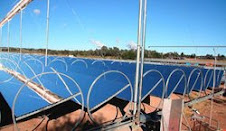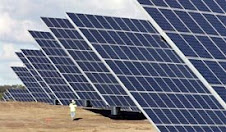Beijing, China [RenewableEnergyAccess.com] Speaking at the Beijing International Renewable Energy Conference (BIREC), Chinese officials this week announced a bolstered commitment to renewable energy that includes a doubling of its current use of renewable energy to 15 percent of the country's energy mix by the year 2020.
China's new national renewable energy law comes into effect next year that sets tariffs in place to foster renewable energy use. Leading up to this proposal, the Chinese government had originally stated a goal of reaching 10 percent renewable energy use by 2020. This higher-level 15 percent commitment raises a renewable energy standard that had already been lauded around the world as a crucial step for a nation with limited and largely coal-based energy resources and a rapidly growing economy.
According to China Daily, investments of up to 1.5 trillion yuan (USD$ 184 billion) will be made in order to reach this goal. China is already the world leader in the use of solar thermal hot water systems and these new commitments could make it a major player with the other renewable energy technologies like solar photovoltaics, wind power, and biofuels.
Zhang Guobao, vice minister of the National Development and Reform Commission, told China Daily that the business sector, instead of Government, will play a leading role in the investment and that international cooperation would be essential for China to meet its goals.
There will be many stand-alone and distributed-generation renewable energy opportunities as the government planned to specifically step up efforts to make renewable energy electricity available to the country's approximately 30 million people who do not have access to grid electricity.
A 15 percent renewable energy commitment will mean a lot of renewable energy but the reality is that the bulk of this commitment will be in large hydropower.
According to reporting from the Reuters news agency, Zhang Guobao also said that hydropower-driven generators would generate 290 million kilowatts (kW) by that year, while biomass energy capacity would hit 20 million kW, wind 30 million kW and solar 2 million kW.
The UK-based Guardian Unlimited newspaper said environmentalists have characterized Beijing's new renewable energy target as a good first step but "still not ambitious enough to offset the climatic damage caused by its spectacular economic growth, which will continue to be predominantly fuelled by coal."
"Environmentalists concerned about the impact of dams, which are ruining some of the world's most beautiful rivers, will be alarmed that hydropower is considered the main alternative to coal and oil," the Guardian article stated.
It's little coincidence that GE Energy's hydropower operations in Asia celebrated the grand opening just over a week ago of a new, 43,000 square-meter, flagship manufacturing, engineering and service center in Hangzhou, China. Company officials described it as a "critical platform" in China and Asia for GE Energy.
Despite what may appear as a good first step effort, an inescapable reality for China is that the country's ongoing commitment to renewables -- whether largely through hydropower or not -- will do little to lesson the country's use of coal as the primary means for electrical production. The country currently uses coal for 70 percent of electricity in China and speakers at BIREC admitted that figure was not expected to change anytime soon.
Best Green Stocks Investing Blog
Sunday, November 13, 2005
Subscribe to:
Post Comments (Atom)
Yuya Joe Blog
Lake Ontario Waterkeeper
The Daily Beast -Politics Blog
21stArch.com - 21st Century Architecture
Original Joe College Blog
WikiLeaks Foreign Policy Analysis
AGreenRealtor.com Real Estate Blog - Ecology Energy Efficiency
Best Green Stocks Investing Blog
PV Intell Photovoltaic Solar Stocks Investing
SEARCH Leading Alternative Energy and Ethical Investing websites

Custom Search
Daily Kos
Rare Earth Stocks Research
Patrick MacManus's Blog Peace and Collaborative Development
BeesTreesFrogsElephants.com - Nature and Ecology Blog
Research Green Energy stocks, Clean Energy investing information
Find wind power investing info online, clean energy mutual funds, geothermal stocks, solar energy investments.

Green Energy Investing Network:
Green Stocks Investing Clean Power Blog
SolarIntell.com Renewable Power Investing Website
Wind Intell.com Wind Energy Stocks Company Links
Geothermal Power Investing Public Companies
PV Intell.com Leading Photovoltaic Solar Energy Stocks

Custom Search
Green Energy Investing Network:
Green Stocks Investing Clean Power Blog
SolarIntell.com Renewable Power Investing Website
Wind Intell.com Wind Energy Stocks Company Links
Geothermal Power Investing Public Companies
PV Intell.com Leading Photovoltaic Solar Energy Stocks







No comments:
Post a Comment